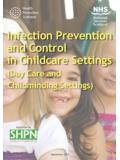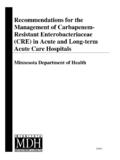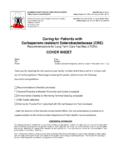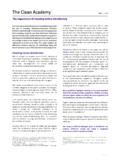Transcription of Carbapenemase Producing Enterobacteriaceae (CPE ...
1 Carbapenemase Producing Enterobacteriaceae (CPE). prevention and management Toolkit for Inpatient Areas This toolkit includes examples advice leaflets and forms which may be helpful for use by teams or adapted for use locally Version : June 2013. Healthcare worker information leaflet: Carbapenemase Producing Enterobacteriaceae (CPE). What are Carbapenemase Producing Enterobacteriaceae (CPE)? Carbapenemase Producing Enterobacteriaceae (CPE) are a type of extremely antibiotic resistant bacteria. The Enterobacteriaceae are a family of Gram negative bacteria (sometimes called coliforms). which are part of the normal bacterial gut flora. They include common pathogens such as E. coli, Klebsiella sp, Proteus sp and Enterobacter spp. These organisms are some of the most common causes of many infections such as urinary tract infections, intra-abdominal infections and bloodstream infections. Carbapenems are a class of very broad spectrum intravenous antibiotics which are reserved for serious infections or when other therapeutic options have failed.
2 What causes Carbapenem Resistance and what are CPE and CRE? Enterobacteriaceae which have become resistant to carbapenems are sometimes called Carbapenem Resistant Enterobacteriaceae (CRE). There are different ways in which this resistance can occur, but the most concerning group from a clinical and infection control perspective are those organisms which carry a Carbapenemase enzyme that breaks down carbapenem antibiotics. This type of CRE is called Carbapenemase Producing Enterobacteriaceae (CPE) and it is the type which spreads most easily and has caused most outbreaks worldwide. Why are CPE of concern? Enterobacteriaceae are the commonest cause of urinary tract infections, bloodstream infections (bacteraemia) and intra-abdominal infections, all of which can be life-threatening. Carbapenems have for years been the last line antibiotics for infections caused by multi-drug resistant Enterobacteriaceae . This has now changed with the development of CPE, which are also usually resistant to most other antibiotic classes all penicillin-type antibiotics, ciprofloxacin, gentamicin and others.
3 This leaves very few and sometimes no options for antibiotic therapy. How common are CPE? Over the last decade CPE have spread throughout the world and are now endemic in healthcare facilities in many countries. They are currently uncommon in the UK and most cases have been associated with hospitalisation abroad. However, the prevalence of CPE is increasing and there are already areas in the UK where CPE can be considered endemic. There is a real risk that CPE could become endemic in UK health systems. It is therefore extremely important to identify patients who have been hospitalised abroad as this is currently the greatest risk for CPE carriage. Healthcare worker information leaflet: Carbapenemase Producing Enterobacteriaceae (CPE). Health Protection Scotland Version 1. June 2013. Infection Control measures to be taken when an individual is identified as colonised/infected with a CRE or CPE. As usual, the most important measure to prevent spread is good hand hygiene with soap and water and/or alcohol hand gel.
4 Patients must be isolated in single rooms with ensuite facilities, and contact precautions used when attending to these patients. Please refer to the daily checklist for patients colonised with CPE. Further advice should be sought from the Infection prevention and Control Team. It is important that communication is maintained between the hospital and community care teams, and between teams within the hospital. Healthcare worker information leaflet: Carbapenemase Producing Enterobacteriaceae (CPE). Health Protection Scotland Version 1. June 2013. Carbapenemase Producing Enterobacteriaceae Patient Details CPE Risk Assessment Name: As part of a strategy to prevent spread of CPE the following DOB: advice should be taken and this form completed on CHI: admission for all patients. This form should be kept in the patient's medical record and Ward: will be audited for presence and completion. Is the patient in any of the following groups? Patients Patients Holiday dialysis Previous transferred hospitalised patients known CPE.
5 From any outside colonisation/. hospital outside Scotland in the infection Scotland last 12 months Yes: No: Yes: No: Yes: No: Yes: No: If Yes to one or more of the above, the patient is at increased risk of CPE. carriage and the actions below should be taken To be completed by local IPCT. Signature Designation Date Ward Site_____. Carbapenemase Producing Enterobacteriaceae CPE Risk Assessment Health Protection Scotland Version 1. June 2013. PRACTICAL ADVICE ON HOW TO SCREEN FOR. Carbapenemase Producing Enterobacteriaceae (CPE). A rectal swab is the sample of choice for CPE screening. Alternatively, a stool sample can be sent ( in children or if patient refuses a rectal swab). A rectal swab should be taken using a routine bacteriology swab. The swab is inserted gently into the rectum, and rotated gently to ensure faecal material is sampled. Place the swab back into the transport medium and transport the specimen to the microbiology laboratory. Stool samples should be collected in the same way as they are for routine culture.
6 Patients with wounds or lesions should have these swabbed using a bacteriology swab (in addition to the rectal swab or stool sample). Patients with urinary catheters should have a Catheter Specimen Urine sent (in addition to the rectal swab or stool sample). Use a routine Bacteriology request form. Request M,C&S and in the clinical details write: For Carbapenemase Producing Enterobacteriaceae (CPE) screen . If the screen is positive the Infection prevention and Control Team will communicate further with you. Please note that if the patient requires an MRSA screen as well, then separate samples need to be sent for MRSA and CPE screening. Practical advice on how to screen for Carbapenemase Producing Enterobacteriaceae (CPE). Health Protection Scotland Version 1. June 2013. Checklist for Patients with CPE Colonisation/Infection: Admission / / Date of sample / / Date or result / / Date ward / /. date collected reported notified Please initial which measures have been applied and review daily for duration of patient stay DATE.
7 Patient isolated in side room with ensuite facilities with door closed and appropriate contact precautions door poster displayed Placement If patient moved from bay to side room, whole bay terminally cleaned including horizontal surfaces (with Patient Actichlor Plus) & all screens changed in bay If unable to isolate, inform bed manager and IPCN immediately to obtain single room. Document this event in patient notes. Note: out of hours bed manager must contact duty microbiologist if patient isolation not possible Alcohol hand rub in patient's room/bed space All staff/visitors must perform hand hygiene with alcohol hand rub before leaving the room. Note: if staff/visitors' hands are visibly soiled soap & water must be used before applying alcohol hand rub Infection Control Measures All staff to wear gloves and aprons for direct contact with patient or their environment and remove these after attending patient Note: where any part of staff uniform not protected by an ordinary apron is expected to come into contact with the patient, a long-sleeved disposable gown should be used when assisting movement in a dependent patient Minimise amount of equipment in patient's room Remove fans or other equipment that could exacerbate any environmental contamination Patient notes and charts to be kept outside patient room Dedicate patient care equipment (stethoscope, BP manometer, thermometer) in patient's room Nursing and domestic staff to commence environmental cleaning/disinfection of room and equipment using a solution of sodium hypochlorite with concentration of 1000 ppm Actichlor Plus.
8 Room to be cleaned daily. Frequently touched surfaces and toilets to be cleaned twice daily and when visibly soiled. Check patients do not have invasive devices that are no longer clinically required or that have signs of inflammation/infection Patient informed of result Patient Information Leaflet provided and explained (document in notes. Include family, if patient consents). Information Treatment Education given at ward level by a member of the IPCT on CPE. and Ward staff provided with information sheet on CPE. Daily washing of patient with Chlorhexidine gluconate 4% aqueous solution ( Hibiscrub) if advised by IPC. Antibiotic therapy reviewed by patient's medical team Checklist for patients with CPE Colonisation/Infection Health Protection Scotland Version 1. June 2013. Patient Information Leaflet Carbapenemase Producing Enterobacteriaceae (CPE). What does CPE mean? CPE stands for Carbapenemase Producing Enterobacteriaceae . This is the name given to a group of germs (bacteria) which have become very resistant to antibiotics including those called carbapenems.
9 This germ usually lives harmlessly in the gut of all humans and animals and helps us digest our food. However, if they get into the wrong place such as the bladder or bloodstream they can cause infection. Why does carbapenem resistance matter? Carbapenem antibiotics are a powerful group of antibiotics that can only be given in hospital directly into the blood stream with a needle. Until now, they were antibiotics that could always be relied upon when other antibiotics failed. Do CPE need to be treated and, if so, how? Because the Enterobacteriaceae normally live in the gut without causing problems (this is called colonisation') they do not always need to be treated. However, if they cause an infection then treatment is required. Infections caused by CPE can be very difficult to treat with antibiotics. This is why it is so important to prevent the spread of CPE. How will I know if I am at risk of CPE? The main risk factor for CPE is having been in a hospital abroad and being exposed to other carriers of CPE.
10 If you have these risk factors we will ask to screen you. How do you screen for CPE? The screening method requires a swab to be inserted just into your rectum (bottom) and the specimen will be sent to see what germs grow. Alternatively a sample of faeces can be sent and sometimes other swabs may also be required. A result will normally take 48-72 hours to be available and the clinical team who are treating you will inform you directly of the results. Advantages of CPE screening It will tell us whether you carry this organism. This means that all appropriate precautions can be taken when you are receiving healthcare to keep the risk of infection to a minimum. What if I have CPE? CPE do not usually cause problems to people who are otherwise fit and healthy, and you may not suffer any effects from carrying CPE. However, antibiotic treatment to prevent or treat any infections may be more complicated when you are carrying CPE. If you are in hospital then you will be asked to remain in a single room for the duration of your stay and staff caring for you will carry out additional infection prevention and control precautions.




